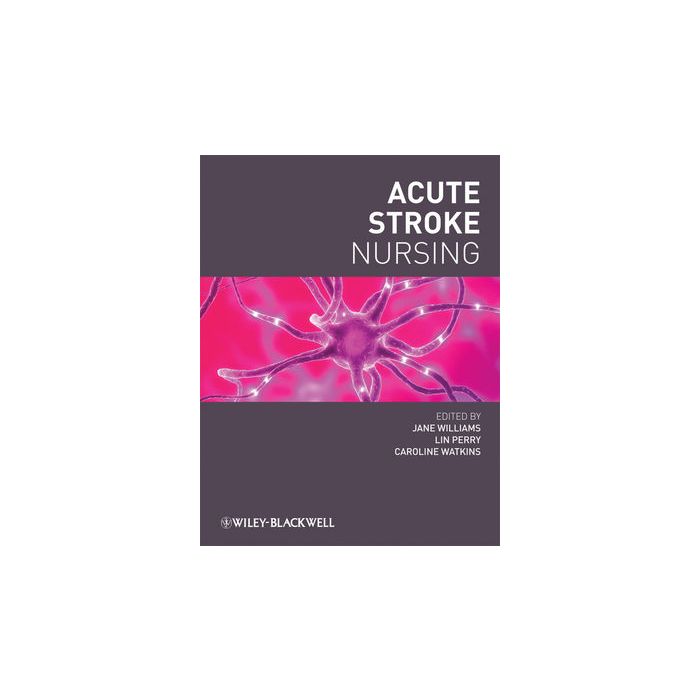Acute Stroke Nursing [Williams; Perry; Watkins - Wiley - Blackwell]

- ISBN/EAN
- 9781405161046
- Editore
- Wiley - Blackwell
- Formato
- Brossura
- Anno
- 2010
- Pagine
- 368
Disponibile
50,00 €
Stroke is a medical emergency that requires immediate medical attention. With active and efficient nursing management in the initial hours after stroke onset and throughout subsequent care, effective recovery and rehabilitation is increased. Acute Stroke Nursing provides an evidence-based, practical text facilitating the provision of optimal stroke care during the primary prevention, acute and continuing care phases.
This timely and comprehensive text is structured to follow the acute stroke pathway experienced by patients. It explores the causes, symptoms and effects of stroke, and provides guidance on issues such as nutrition, continence, positioning, mobility and carer support. The text also considers rehabilitation, discharge planning, palliative care and the role of the nurse within the multi-professional team. Acute Stroke Nursing is the definitive reference on acute stroke for all nurses and healthcare professionals wishing to extend their knowledge of stroke nursing.
Evidence-based and practical in style, with case studies and practice examples throughout
Edited and authored by recognised stroke nursing experts, clinicians and leaders in the field of nursing practice, research and education
The first text to explore stroke management from UK and international perspectives, and with a nursing focus
Maggiori Informazioni
| Autore | Williams Jane; Perry Lin; Watkins Caroline |
|---|---|
| Editore | Wiley - Blackwell |
| Anno | 2010 |
| Tipologia | Libro |
| Lingua | Inglese |
| Indice | 1 Setting the scene(Caroline Watkins and Michael Leathley) Introduction Stroke epidemiology Stroke policy Stroke management strategies Research and education Conclusion References 2 Developing stroke services: a key role for nursing and nurses (Christopher R. Burton) Introduction Service development The nursing contribution to stroke services The political agenda shaping stroke service development Conclusion References 3 What is a stroke? (Anne W. Alexandrov) Introduction Stroke development processes Risk factors for stroke Anatomy, physiology and related stroke clinical findings Standardised instruments for acute neurological assessment Conclusion References 4 Acute stroke nursing management (Anne W. Alexandrov) Introduction Priorities in acute stroke management Hyperacute stroke management Acute stroke management Conclusion References 5 Nutritional aspects of stroke care (Lin Perry and Elizabeth Boaden) Introduction Do stroke patients experience nutritional problems pre-stroke? How does stroke affect dietary intake? How can stroke patients be helped to maintain adequate dietary intake? Conclusion References 6 Promoting continence (Kathryn Getliffe and Wendy Brooks) Introduction Bladder problems and urinary incontinence Bowel problems and bowel care Conclusion References 7 Management of physical impairments post-stroke (Cherry Kilbride and Rosie Kneafsey) Introduction Movement Moving and handling people with stroke Therapeutic positioning and seating in the acute phase Promoting early mobilisation Falls prevention Restoration and re-education of movement Management of the upper limb Further rehabilitation strategies and novel developments Patients’ perspective on mobility rehabilitation Conclusion References 8 Communication (Jane Marshall, Katerina Hilari and Madeline Cruice) Introduction Communication impairments caused by stroke Language minorities The role of the speech and language therapist in acute stroke care Psychosocial issues and quality of life Conclusion References 9 Mood and behavioural changes (Peter Knapp) Introduction Psychological reactions to the onset of stroke Conclusion References 10 Minimally responsive stroke patients (Elaine Pierce and Aeron Ginnelly) Introduction Definitions and identification Minimally responsive state ‘Locked-in’ syndrome Conclusion References 11 Rehabilitation and recovery processes (Jane Williams and Julie Pryor) Introduction Initiation of rehabilitation Outcomes of rehabilitation Recovery processes Transfer to rehabilitation Rehabilitation provision Conclusion References 12 Stroke and palliative care: a difficult combination? (Christopher R. Burton and Sheila Payne) Introduction Palliative care Relevance of palliative care to stroke Organisational challenges Conclusion References 13 Reducing the risk of stroke (Peter Humphrey, Jo Gibson and Stephanie Jones) Introduction Primary prevention Secondary prevention: identifying those at risk of stroke Public awareness and access to services Secondary prevention of stroke in less common aetiologies and patient groups Conclusion References 14 Longer-term support for survivors and supporters (Louise Brereton and Jill Manthorpe) Introduction Leaving hospital What is required longer term? What do carers want? Conclusion References 15 Stroke resources for professionals, patients and carers (Graham Williamson) National associations Resources for patients and carers Other resources and organisations Specialist international journals Non-specialist journals’ stroke collections Clinical practice guidelines Finding current stroke research Evidence-based practice resources Chapter links Index |
Questo libro è anche in:
